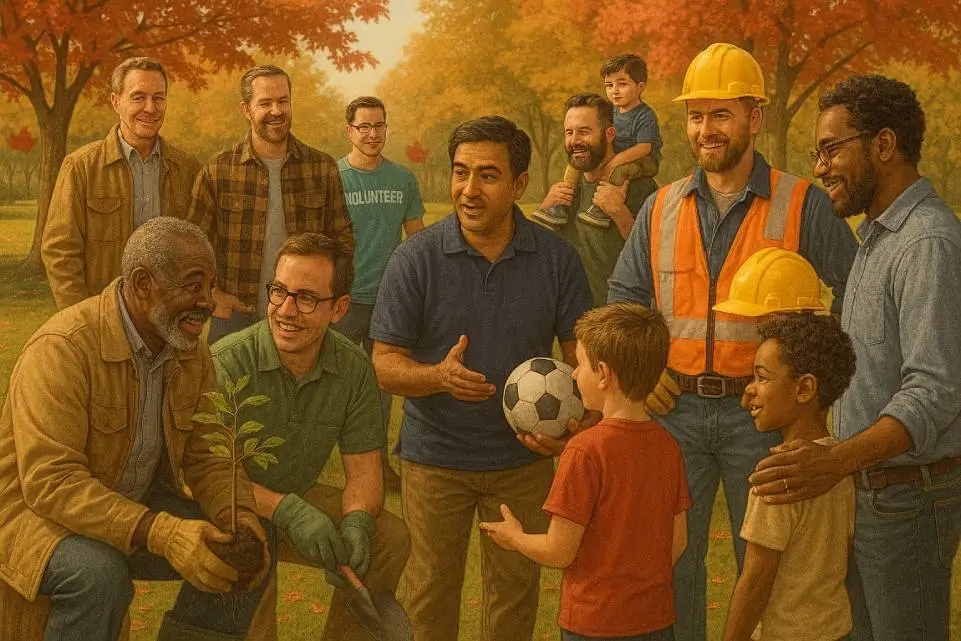International Men’s Day in Canada
International Men’s Day in Canada: Celebrating Male Contributions and Addressing Modern Challenges

Have you ever wondered why we set aside a special day to celebrate the men in our lives? I certainly have. Growing up in Toronto, I remember my dad quietly going about his business—working long hours, fixing things around the house, and never complaining. It wasn’t until I was older that I realized how much he sacrificed without ever expecting recognition.
That’s partly what International Men’s Day is about—acknowledging those contributions that often go unnoticed. But it’s about so much more too.
Why Do We Celebrate International Men’s Day?
International Men’s Day, celebrated annually on November 19th, isn’t just another date on the calendar. It’s a day dedicated to recognizing men’s positive contributions to society, highlighting the unique challenges they face, and promoting gender equality in its truest sense.
I was surprised to learn that many Canadians don’t know about this day. While we’re all familiar with International Women’s Day in March (and rightfully so!), International Men’s Day tends to fly under the radar. But the day serves important purposes that benefit everyone in our society.
The celebration focuses on six key pillars:
- Promoting positive male role models
- Celebrating men’s positive contributions
- Focusing on men’s health and wellbeing
- Highlighting discrimination against men
- Improving gender relations and equality
- Creating a safer world for everyone
As Dr. Warren Farrell, author of “The Boy Crisis,” puts it: “The purpose of International Men’s Day is not to compete with International Women’s Day, but to highlight the importance of men’s physical and mental health and positive contributions.”
What Are the Six Pillars of International Men’s Day?
Let’s break down these pillars that form the foundation of International Men’s Day:
1. Promoting Positive Male Role Models
In a world where negative stereotypes about masculinity abound, highlighting positive male role models becomes crucial. These are men who demonstrate compassion, respect, responsibility, and integrity.

From Terry Fox’s determination to Justin Trudeau’s advocacy for gender equality, Canada has its fair share of positive male role models who challenge traditional notions of masculinity while embodying its best qualities.
2. Celebrating Men’s Positive Contributions
Men contribute enormously to families, communities, and society at large. Whether it’s through their professional work, volunteering, mentorship, or family roles, these contributions deserve recognition.
I remember when my neighbor John started a hockey program for underprivileged kids in our community. He devoted countless hours to coaching, fundraising, and even driving kids to and from practices. His impact on those young lives was immeasurable, yet he never sought recognition.
3. Focusing on Men’s Health and Wellbeing
Did you know that men are less likely to seek help for physical and mental health issues? The statistics are sobering:
| Health Concern | Statistics in Canadian Men |
|---|---|
| Suicide Rate | 3-4 times higher than women |
| Life Expectancy | 4 years shorter than women |
| Doctor Visits | 25% less likely to visit a doctor |
| Mental Health | Less likely to seek help for depression and anxiety |
International Men’s Day provides a platform to discuss these issues openly and encourage men to prioritize their health.
4. Highlighting Discrimination Against Men
While we’ve made great strides in addressing discrimination against women, some areas where men face systemic challenges deserve attention too. These include:
- Family court disparities
- Higher rates of workplace fatalities
- Educational challenges (boys are now less likely to attend university)
- Homelessness (men make up approximately 70% of homeless individuals in Canada)
Acknowledging these issues isn’t about diminishing women’s struggles but recognizing that gender equality means addressing unfairness wherever it exists.
5. Improving Gender Relations and Equality
True gender equality benefits everyone. International Men’s Day encourages dialogue between genders, promoting understanding and cooperation rather than competition.
When men and women work together to address gender issues, the results are more balanced and effective. This is about creating partnerships, not polarization.
6. Creating a Safer World for Everyone
By addressing issues like male violence (including violence against other men), promoting emotional intelligence, and encouraging healthy expressions of masculinity, International Men’s Day aims to create a safer world for everyone.
How to Celebrate Men’s Day?
Wondering how to acknowledge International Men’s Day? Here are some meaningful ways:
- Check in on the men in your life. A simple “How are you really doing?” can open important conversations.
- Organize a men’s health event at your workplace or community center.
- Share stories of positive male role models on social media with hashtags like #InternationalMensDay or #CelebrateMen.
- Support male-focused charities like Movember or organizations addressing issues like fatherlessness or male suicide.
- Host a discussion about healthy masculinity and the challenges modern men face.
When I celebrated last year, I took my dad and grandfather fishing—something they both love but rarely make time for. The conversations we had that day were priceless, touching on everything from career pressures to health concerns they’d never mentioned before.
Why Is Women’s Day Celebrated and Not Men’s Day?
Actually, both days are celebrated, but there’s a noticeable difference in recognition. International Women’s Day (March 8) receives significant media attention, corporate sponsorship, and public awareness. International Men’s Day, while growing in recognition, hasn’t yet achieved the same level of visibility.
This disparity exists for several reasons:
- Women’s rights movements have a longer, more documented history of advocacy
- Historical and ongoing gender inequalities affecting women have necessitated more focused attention
- There’s sometimes misunderstanding about the purpose of Men’s Day, with some incorrectly assuming it’s a reaction against Women’s Day
However, both days serve important and complementary purposes. They’re not in competition but rather address unique challenges faced by each gender while promoting overall equality.
Do Companies Celebrate International Men’s Day?
Increasingly, yes! Forward-thinking Canadian companies are recognizing the value of celebrating International Men’s Day alongside other diversity initiatives. Here’s how some organizations mark the occasion:
- Health-focused initiatives: Offering free health screenings or mental health workshops
- Panel discussions: Hosting conversations about modern masculinity and men’s challenges
- Mentorship programs: Launching initiatives that pair experienced male employees with younger colleagues
- Work-life balance campaigns: Encouraging men to prioritize family time and personal wellbeing
Companies like Bell Canada through their Bell Let’s Talk mental health initiative have incorporated men’s mental health awareness into their broader campaigns, recognizing that addressing men’s unique challenges benefits the entire workplace.
Which Theme Is Often Associated with International Men’s Day?
Each year, International Men’s Day adopts a specific theme to guide celebrations and discussions. These themes highlight different aspects of men’s experiences and challenges.
Recent themes have included:
- “Better health for men and boys”
- “Positive male role models”
- “Working to expand reproductive options for men”
- “Helping men and boys live longer, happier, healthier lives”
The theme for 2025 is expected to focus on men’s mental health and emotional wellbeing, particularly relevant in our post-pandemic world where isolation and anxiety have affected so many.
How to Wish Men’s Day to Their Boyfriend?
Looking for ways to acknowledge the special man in your life on International Men’s Day? Here are some thoughtful approaches:
- Write a heartfelt card highlighting specific qualities you admire in him
- Plan an activity he enjoys but rarely makes time for
- Create a small care package focused on self-care (yes, men need this too!)
- Cook his favorite meal and use dinner time to have meaningful conversations
- Simply acknowledge the day and tell him why you appreciate his presence in your life
One year, my sister created a “reasons I appreciate you” jar for her husband, filled with 50 small notes detailing specific things she valued about him. He later told me it was the most meaningful gift he’d ever received.
The key is personalizing your approach based on what would resonate most with your partner. Sometimes, simple acknowledgment means more than grand gestures.
Is There an International Women’s Day?
Yes! International Women’s Day is celebrated globally on March 8th each year. This day recognizes women’s social, economic, cultural, and political achievements while highlighting ongoing work toward gender equality.
Both International Women’s Day and International Men’s Day serve valuable purposes in addressing gender-specific challenges and celebrating achievements. They’re complementary rather than competitive observances.
What Is the Importance of Men?
This might seem like an obvious question, but reflecting on it reveals important truths. Men contribute to society in countless ways:
- As fathers, mentors, and role models guiding younger generations
- Through their work across all sectors of the economy
- Via community leadership and volunteer efforts
- By supporting families emotionally and financially
- Through innovations and problem-solving in various fields
Beyond these tangible contributions, men bring unique perspectives and approaches that complement other genders. Diversity—including gender diversity—strengthens our communities and institutions.
As anthropologist Margaret Mead observed, “Every society needs the contributions of both men and women to thrive and continue.”
When Did Women’s Day Start?
International Women’s Day has a long history dating back to 1908, when 15,000 women marched through New York City demanding voting rights, better working conditions, and equal pay. The first official International Women’s Day was celebrated in 1911.
By comparison, International Men’s Day was established much later, in 1999 by Dr. Jerome Teelucksingh in Trinidad and Tobago. The day was chosen to honor his father’s birthday and to celebrate how on that day in 1989, Trinidad and Tobago’s soccer team had united the country in their efforts to qualify for the World Cup.
Understanding this historical context helps explain why Women’s Day has greater recognition—it has a longer established history and emerged from specific historical struggles for basic rights.
International Men’s Day offers a valuable opportunity to acknowledge men’s contributions, address their unique challenges, and promote a healthier vision of masculinity that benefits everyone. Far from competing with women’s advocacy, it complements these efforts by recognizing that gender equality means addressing inequalities wherever they exist.
Here in Canada, with our strong values of inclusivity and equality, we have a special opportunity to lead by example—celebrating both International Women’s Day and International Men’s Day with equal enthusiasm and thoughtfulness.
The next International Men’s Day is coming up on November 19th. How will you recognize the day? Whether it’s checking in on the men in your life, supporting male-focused charities, or simply starting conversations about men’s wellbeing, your participation matters.
After all, when we support healthier expressions of masculinity and address men’s challenges, everyone benefits—men, women, and society as a whole.


